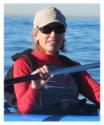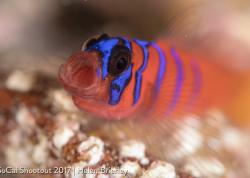Wide Angle and Macro with the Nikon D850 and D500 in the Sea of Cortez
The Nikon D850 and the Nikon D500 are two fo the most capable cameras on market currently for use in underwater photography. Let's take a look at the results when both of them are used on a recent dive trip - The D850 for wide-angle, and the D500 for macro.
Equipment Used - Wide Angle
- Nikon D850
- NIkon 16-35mm F4 VR lens
- Nauticam D850 Housing
- 8-inch acrylic dome port
Equipment Used - Macro
- Nikon D500
- Nikon 105mm VR F2.8 macro lens
- Nauticam D500 Housing
- Subsee +5 diopter and +10 diopters
- Nauticam flip adapter
- Sola 2500 flood light
- Bluewater 1000 focus light
The 46 megapixel full-frame sensor on the D850 and its excellent auto-focus capabilities makes it ideal for wide-angle photography. The 16-35mm lens is a fast focusing lens, sharp behind a dome port, and able to zoom in for skittish subjects like bull sharks, hammerhead sharks, or mobula and manta rays.
The D500, on the other hand, is ideal for macro and supermacro with its cropped sensor, and it retains many of the advantages of the D850. Using both the D850 and the D500 on a trip means not having to change ports & lenses, and being able to quickly swap setups if necessary.
Both the 16-35mm and 105mm lenses used are AF-S lenses, which means they have an internal auto-focus motor. That is important, because AF-S lenses focus faster than lenses whose auto-focus is driven by the camera body, and it important when trying to capture behaviour shots.
Straight out of the camera photos from the D850 look noticeably better than either the D500 or the D810, possibly due to its brighter pixels and better low-light capabilities.
Autofocus in the 3D tracking mode was used with the D850 for wide-angle, and spot focus in continous focus mode was used with the D500.
For settings, see the captions below each photo.
Trip Details and Underwater Photography
Our Explore Baja, Sea of Cortez trip in early October 2018 on the Rocio Del Mar was to take us from San Jose del Cabo in the south all the way to Puerto Peñasco in the north – a distance of around 600 nautical miles over 12 days. The biodiversity of the Sea of Cortez is world renowned and we were all excited to get underway and begin our journey of underwater exploration. Exactly what you will see in this diverse bit of ocean is always unpredictable, but you can always rely on some amazing encounters with creatures both large and small. This was perhaps a less predictable trip than usual, with a hurricane forecast to move across the Baja peninsula in the middle of our cruise. A little juggling of the usual itinerary became necessary, but we were confident in the crew’s assurances that we’d still get in plenty of dives and see an incredible array of marine life.
Onboard ship, the days start early, with a pre-breakfast dive as soon as the sun pokes its head over the horizon, before any day boats have even left port. We encountered very few other divers the whole time we were there – one of the benefits of exploring in such a sparsely populated region.

Our second day of diving ended with a spectacular night dive. We watched hundreds of mobula rays feeding on the plankton attracted to bright lights positioned by the crew in nearby shallow waters. Again and again they swooped down over our heads in formation, then up into the lights only to circle back around, fan out across the sand and swerve in unison for another fly by.
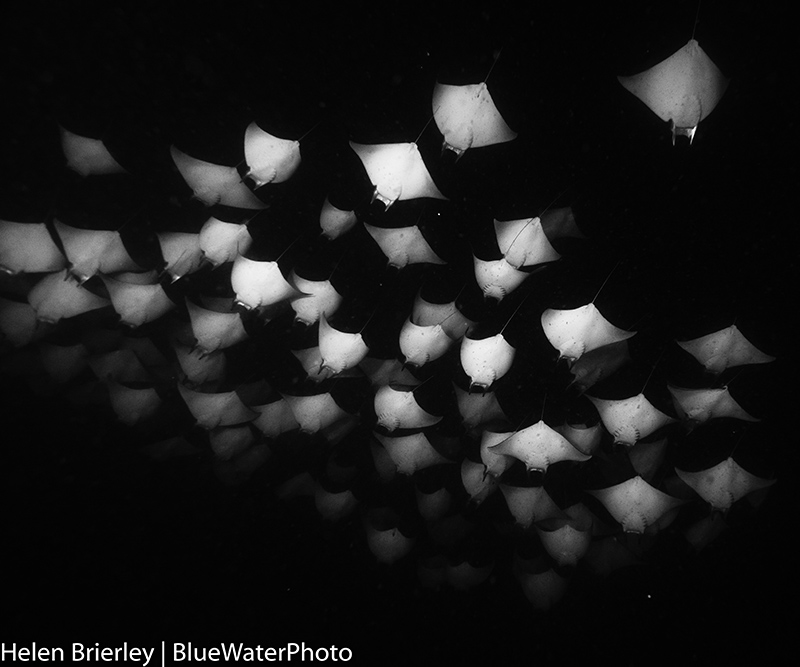
Often the last dive of the day was at dusk, a time of increased activity on the reef when the hunting and mating action intensifies as the last yellow rays slant through the water. We would surface to the deep orange glow of sunset and the swirling spirals of thousands of sea birds coming home to roost, mimicking the movement of the schooling fish below.
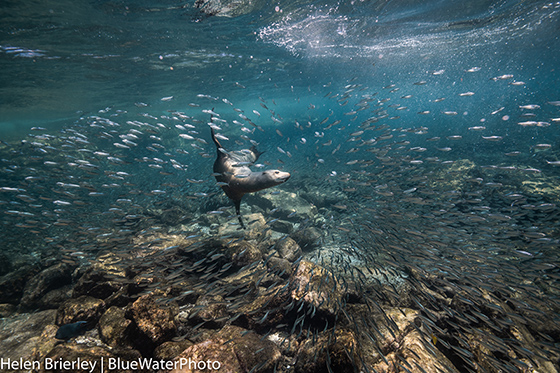
The food on board was great – plentiful and always beautifully presented, with lots of Mexican flavors and wonderful desserts every evening. A couple of very pleasant evenings were spent dining in the open air on the top deck with a fabulous barbecue buffet accompanied by plentiful margaritas.
One day, a huge pod of dolphins surrounded the boat and the captain turned full circle and slowed to their pace so they would play longer with us. “Hurricane protocol” necessitated a day holed up in the Bay of La Paz, but with 12 days of diving we did not feel too cheated by Mother Nature and were happy to be avoiding the brunt of the storm.
Our luck with rays continued at La Reina – we were privileged to witness the return of the giant Pacific mantas to the Sea of Cortez. Ducking from some ripping currents, we were awestruck by their effortless grace and calm, easy movement. Our photographs and video clips will be used to help researchers monitor and learn more about the behavior patterns of these gentle giants and hopefully lead to some protections for the species.
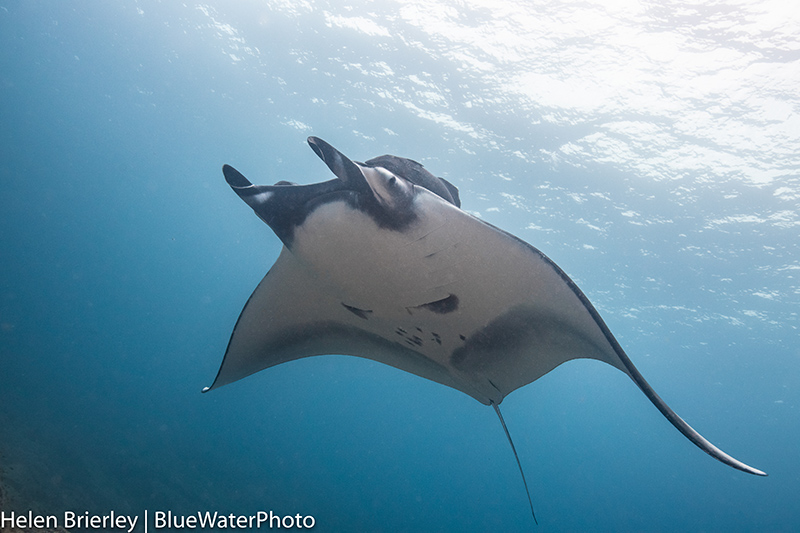
Conditions at El Bajo were spectacular – a little too calm for the hammerheads’ taste, but we were treated to a beautiful view of the whole dive site with barely any current and watched intently as turtles came in for their cleaning rituals.
At several sites we had a lot of fun lying in wait for the signal blennies to perform, the pike blennies to show some aggression and the jawfish to rise up briefly into the water column. All the dive sites provided opportunities for both macro and wide angle images and every day we had a presentation and image reviews to hone our skills and better capture the amazing creatures and scenes we were witnessing.
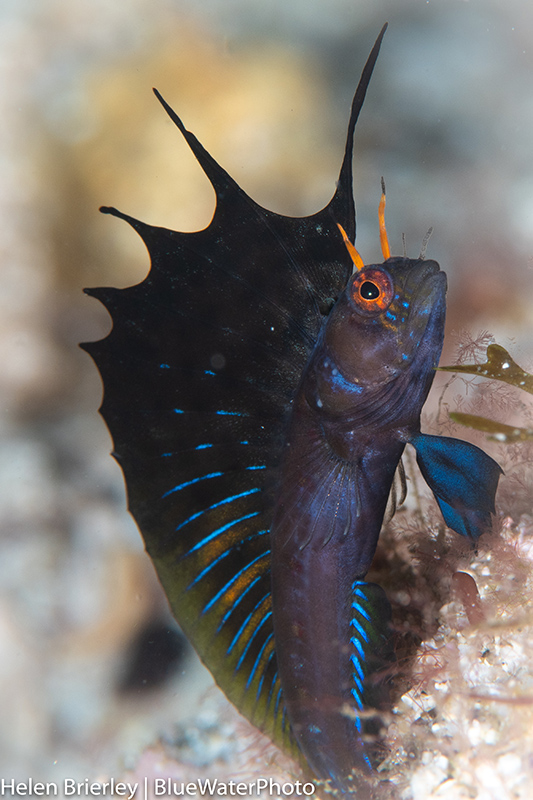
No trip report from the Sea of Cortez would be complete without mention of the playful sea lions encountered at several of the dive sites we visited. When I found myself lying on the sand waiting for a giant jawfish to emerge from its hole, getting dive bombed by frisky sea lions with a school of barracuda swirling overhead, I could not help thinking this is as good as it gets!
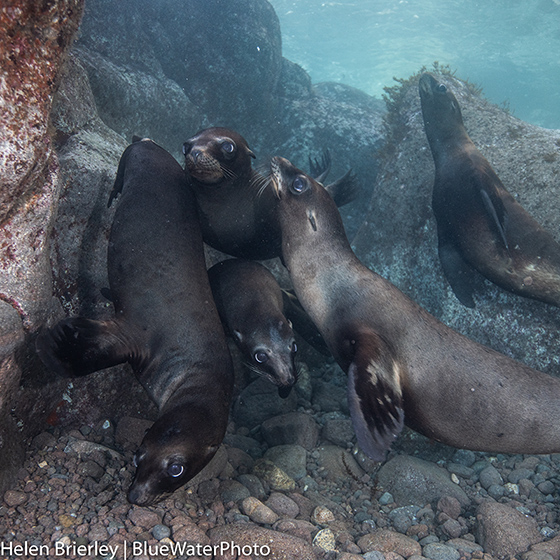
From the very beginning of our adventure, to the time we all left the boat, the crew went out of their way to help in any way they could and to ensure that a fantastic time was had by every guest. All in all, it was a great trip with a really fun group from across the US and Europe, and some lasting friendships were made.
More Underwater Photos:
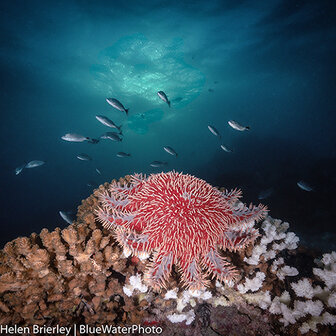
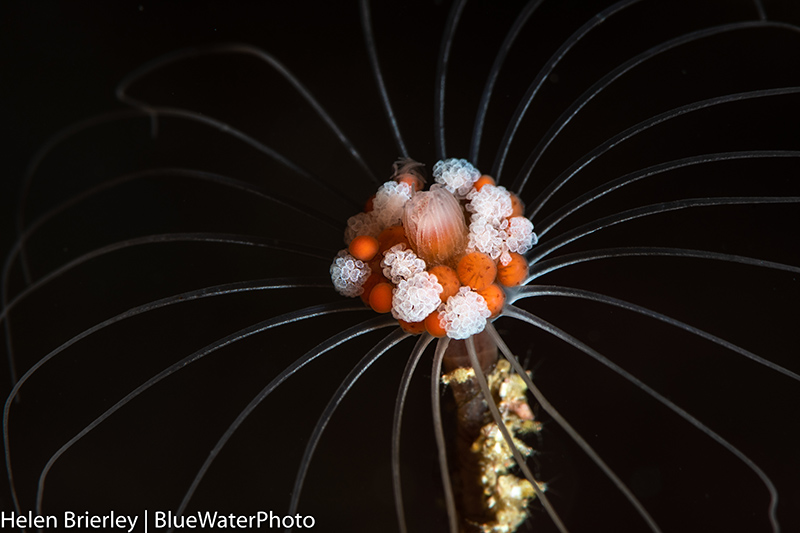
Join an Explore Baja trip
We are running an "Expore Baja" trip again, join us for Explore Baja 2019, or Explore Baja 2020!
RECOMMENDED ARTICLES
SUPPORT THE UNDERWATER PHOTOGRAPHY GUIDE:
The Best Service & Prices on u/w Photo Gear
 Visit Bluewater Photo & Video for all your underwater photography and video gear. Click, or call the team at (310) 633-5052 for expert advice!
Visit Bluewater Photo & Video for all your underwater photography and video gear. Click, or call the team at (310) 633-5052 for expert advice!
The Best Pricing, Service & Expert Advice to Book your Dive Trips
 Bluewater Travel is your full-service scuba travel agency. Let our expert advisers plan and book your next dive vacation. Run by divers, for divers.
Bluewater Travel is your full-service scuba travel agency. Let our expert advisers plan and book your next dive vacation. Run by divers, for divers.







